192. Catherine Palace, the Kameronova Gallery, and the Arsenal Pavilion
When I visited Tsarskoye Selo in December, I spent the afternoon enjoying the winter landscape and assortment of monuments, bridges, and follies spread throughout Catherine Park and Alexander Park. I also reserved several hours to tour three of the main buildings: Catherine Palace, the Kameronova Gallery, and the Arsenal Pavilion.
This was my second visit to Catherine Palace - I had previously toured it back in July (it was the first of the suburban palaces that I visited, in fact). However, it was a substantially different experience the second time around. As one of the more popular tourist destinations in the St. Petersburg area, it was crowded with visitors in the summer. I was unaware at the time, but there are multiple routes through the palace during the crowded summer months, most of which are shorter than the full palace route and all of which skip different sections of the building. When I was there in the summer, I saw all of the main rooms in the palace and listened to the majority of the audio guide. So, I had no idea that I in fact missed approximately 15 rooms as a result of this crowd control technique.
The first section of new rooms that I explored is in the western end of the main palace building. They include a row of three large antechambers off the Grand Hall, Catherine the Great's dressing room, the Arabesque room, and the Lyons hall (with a beautiful collection of marble and lapis lazuli furnishings and decorative elements). There is also an exhibit of contemporary sculpture on display in this part of the palace. These rooms are the equal of the highlights of the other restored areas of the palace, including my favorites - the Grand Hall, Amber Room, and Paul I's dining room.
The second section of new rooms was on the eastern end of the palace. These are not decorated in the grand style of the primary route through the fully restored section of the palace, but are instead filled with furniture, clothing, and personal effects of Emperor Alexander I and his family. Alexander I enjoyed Catherine Palace as the favorite of his many homes, perhaps because he had fond memories of childhood summers spent here with his grandmother (Catherine the Great). His personal rooms included a drawing room, dressing room, bedroom, study, and two dining rooms (the Small White Dining Room and the Hermitage Dining Room). Alexander I's brother (and successor) Nicholas I decided to preserve these rooms as a memorial after Alexander's death in 1825. No member of the royal family ever lived in these rooms again, and the furnishings remained in place until World War Two. The rooms have not yet been restored to their original condition (even thought the palace renovation began more than 60 years ago), but are used for the same purpose that they had for most of the nineteenth century: to house a collection of Alexander I's personal possessions. Also on display are portraits of many other Emperors, as well as costumes and personal effects from other members of the imperial family from the eighteenth and nineteenth centuries.
Following my tour of Catherine Palace, I headed over to the nearby Kameronova Gallery to see the exhibit inside. A renovation project had started on this building since my last visit, which closed the top floor and outdoor sculpture colonnade to visitors, but the main exhibit hall on the second floor remained open. The current exhibition is entitled "On the Eve...1917", which covers imperial life at Tsarskoye Selo in the years immediately preceding the Russian Revolution. The photographs, videos, and objects tell a fascinating story of an empire on the precipice of change. Unfortunately, there is scant interpretation (and no labels in English), so I left the exhibit wanting more information to better understand the details and context of this story.
The Arsenal Pavilion is located in Alexander Park, in an area to the north of Catherine Palace that was used at one time as an imperial wildlife and game preserve. The pavilion was constructed in 1817-1834 as a Neo-Gothic building according to the designs of architect Adam Menelaws. The central octagonal "Hall of Knights" on the second floor is the most impressive room in the Arsenal Pavilion. The building was intended to house Nicholas I's collection of Western European and Asian arms and armor. In 1885-1886, Alexander III transferred these collections to the Hermitage Museum, where many of the pieces are still on display. The Arsenal Pavilion was heavily damaged during the Second World War, and remained in a dilapidated condition for the remainder of the twentieth century. The St. Petersburg Institute for Special Restoration Projects undertook the repair and restoration of the building from September 2014 to December 2015, and as of autumn 2016 it is once again used to display a portion of the imperial arms and armor collection. Although not a large museum, there are some incredible sixteenth, seventeenth, and eighteenth century rifles, pistols, and bladed weapons here. I remain impressed by Russia's pride in its historical, architectural, and artistic heritage as well as the resources that continue to be used to restore and preserve the area's rich legacy.
***
Catherine Palace:
The Grand Hall:
A view of the before (left) and after (right) state of the cherub gilding restoration project:
The antechambers:
Back in the Grand Hall:
The Amber Room:
The Picture Hall:
Emperor Paul I's dining room:
Emperor Alexander I's apartment rooms:
The Kameronova Gallery:
The Arsenal Pavilion:
This was my second visit to Catherine Palace - I had previously toured it back in July (it was the first of the suburban palaces that I visited, in fact). However, it was a substantially different experience the second time around. As one of the more popular tourist destinations in the St. Petersburg area, it was crowded with visitors in the summer. I was unaware at the time, but there are multiple routes through the palace during the crowded summer months, most of which are shorter than the full palace route and all of which skip different sections of the building. When I was there in the summer, I saw all of the main rooms in the palace and listened to the majority of the audio guide. So, I had no idea that I in fact missed approximately 15 rooms as a result of this crowd control technique.
The first section of new rooms that I explored is in the western end of the main palace building. They include a row of three large antechambers off the Grand Hall, Catherine the Great's dressing room, the Arabesque room, and the Lyons hall (with a beautiful collection of marble and lapis lazuli furnishings and decorative elements). There is also an exhibit of contemporary sculpture on display in this part of the palace. These rooms are the equal of the highlights of the other restored areas of the palace, including my favorites - the Grand Hall, Amber Room, and Paul I's dining room.
The second section of new rooms was on the eastern end of the palace. These are not decorated in the grand style of the primary route through the fully restored section of the palace, but are instead filled with furniture, clothing, and personal effects of Emperor Alexander I and his family. Alexander I enjoyed Catherine Palace as the favorite of his many homes, perhaps because he had fond memories of childhood summers spent here with his grandmother (Catherine the Great). His personal rooms included a drawing room, dressing room, bedroom, study, and two dining rooms (the Small White Dining Room and the Hermitage Dining Room). Alexander I's brother (and successor) Nicholas I decided to preserve these rooms as a memorial after Alexander's death in 1825. No member of the royal family ever lived in these rooms again, and the furnishings remained in place until World War Two. The rooms have not yet been restored to their original condition (even thought the palace renovation began more than 60 years ago), but are used for the same purpose that they had for most of the nineteenth century: to house a collection of Alexander I's personal possessions. Also on display are portraits of many other Emperors, as well as costumes and personal effects from other members of the imperial family from the eighteenth and nineteenth centuries.
Following my tour of Catherine Palace, I headed over to the nearby Kameronova Gallery to see the exhibit inside. A renovation project had started on this building since my last visit, which closed the top floor and outdoor sculpture colonnade to visitors, but the main exhibit hall on the second floor remained open. The current exhibition is entitled "On the Eve...1917", which covers imperial life at Tsarskoye Selo in the years immediately preceding the Russian Revolution. The photographs, videos, and objects tell a fascinating story of an empire on the precipice of change. Unfortunately, there is scant interpretation (and no labels in English), so I left the exhibit wanting more information to better understand the details and context of this story.
The Arsenal Pavilion is located in Alexander Park, in an area to the north of Catherine Palace that was used at one time as an imperial wildlife and game preserve. The pavilion was constructed in 1817-1834 as a Neo-Gothic building according to the designs of architect Adam Menelaws. The central octagonal "Hall of Knights" on the second floor is the most impressive room in the Arsenal Pavilion. The building was intended to house Nicholas I's collection of Western European and Asian arms and armor. In 1885-1886, Alexander III transferred these collections to the Hermitage Museum, where many of the pieces are still on display. The Arsenal Pavilion was heavily damaged during the Second World War, and remained in a dilapidated condition for the remainder of the twentieth century. The St. Petersburg Institute for Special Restoration Projects undertook the repair and restoration of the building from September 2014 to December 2015, and as of autumn 2016 it is once again used to display a portion of the imperial arms and armor collection. Although not a large museum, there are some incredible sixteenth, seventeenth, and eighteenth century rifles, pistols, and bladed weapons here. I remain impressed by Russia's pride in its historical, architectural, and artistic heritage as well as the resources that continue to be used to restore and preserve the area's rich legacy.
***
Catherine Palace:
The Grand Hall:
A view of the before (left) and after (right) state of the cherub gilding restoration project:
The antechambers:
Back in the Grand Hall:
The Amber Room:
The Picture Hall:
Emperor Paul I's dining room:
Emperor Alexander I's apartment rooms:
The Kameronova Gallery:
The Arsenal Pavilion:
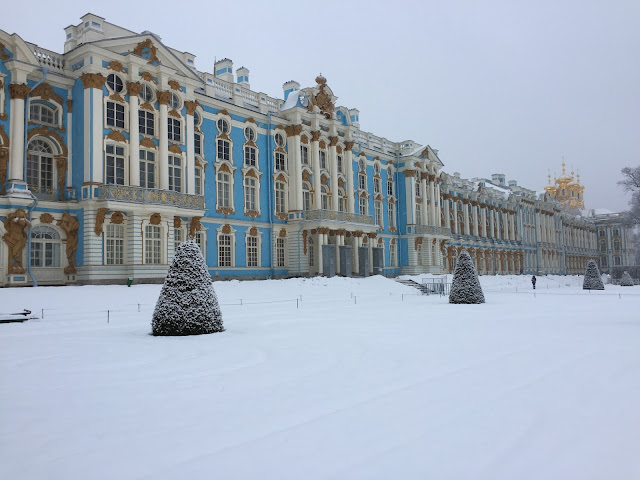




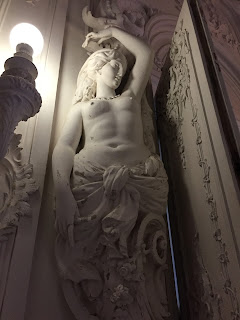































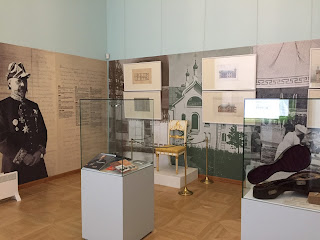














































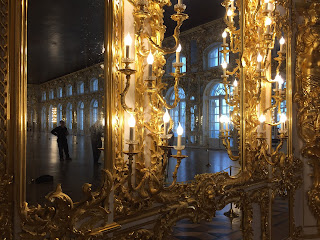














































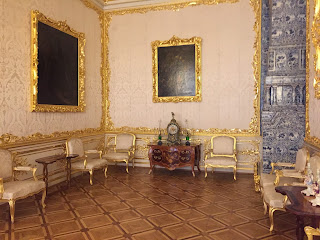
























































































Comments
Post a Comment